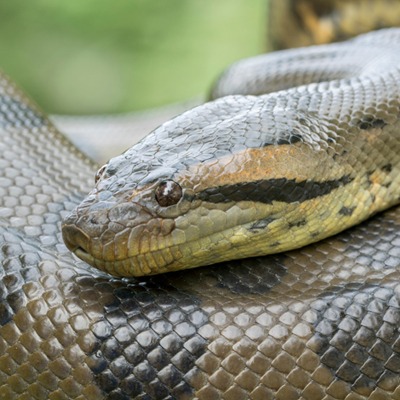
About Green Anaconda
Green anacondas are one of the largest snakes in the world. Normally, they are solitary creatures and stay within their own hunting area. Reports of anaconda attacks on humans are rare. However, these boas can take down large prey, including jaguars.
Habitat
Green anacondas live in streams, rivers, swamps, and marshes. They are found throughout tropical South America, mainly in the Amazon and Orinoco basins.
Diet
Green anacondas are carnivores who eat any animal they can catch! That includes large rodents, tapirs, capybaras, deer, peccaries, fish, turtles, birds, sheep, dogs, and aquatic reptiles. They are ambush predators who wait very still to surprise their prey until it gets close enough for the anaconda to strike. They grab their prey with their teeth and powerful jaws before wrapping their strong, muscular bodies around their prey. They constrict and squeeze their prey hard and long so when the prey breathes out, the snake can tighten its grip even more so the prey cannot breathe in.
Family Life
Like other boa species, anacondas are ovoviviparous, or birth live young. Clutch, or group of eggs, and birth size are proportional to the female’s size. A clutch could include up to 50 young anacondas ranging from two to three feet in length. The baby snakes can swim and hunt shortly after birth.
Conservation Status
The conservation status of the Green Anaconda is classified as not evaluated.Threats
- Juveniles and small adult anacondas experience high mortality rates, as they are subject to predation by larger predators, including caiman alligators and jaguars.
- To avoid attackers, green anacondas burrow into mud to hide or flee into nearby water to escape dangerous situations. However, when directly attacked or threatened, anacondas coil up into a ball.
Facts about Green Anaconda
Class:
Reptilia (reptile)Order:
Squamata (scaled-reptiles)Family:
Boidae (boas)Genus:
Eunectes (anaconda)Species:
Eunectes murinus (green anaconda)Life Span:
10 years (wild) / 30 years (zoo)Size:
17 – 36 feet (5 – 11 m)Weight:
Up to 500 pounds (227 kg)Diameter:
12 inches (305 mm)
Fun Facts
- A scaly fingerprint! The scales on its belly are yellow and black. The scales on the underside of the tail have a particular pattern, which is unique to each snake. It’s a form of identification, like a human fingerprint.
- The eyes and nostrils are on the top of the green anaconda’s head, enabling the anaconda to breathe and to see its prey while its body lays submerged under water. They can stay completely submerged for ten minutes.
- Females are typically much larger in weight and length than males.